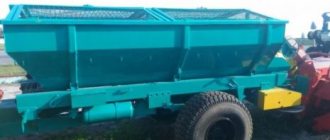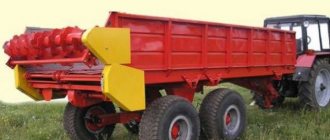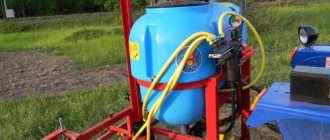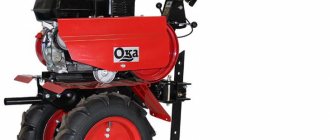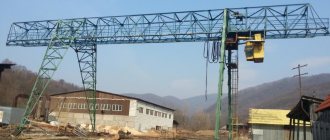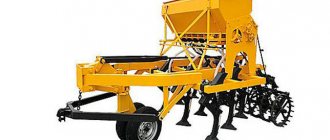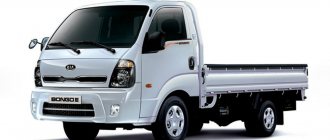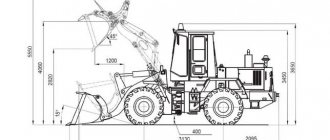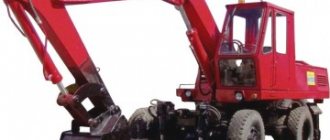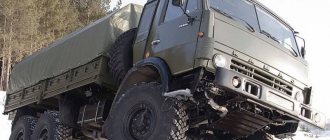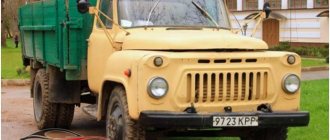To get a good harvest, it has long been customary to feed the soil in the fields with organic matter: manure, peat, chicken droppings. But if earlier this was done manually, spreading fertilizer with shovels, now everything is much simpler. A special spreader machine called ROU-6, attached to a tractor, will fertilize the field much more accurately and quickly.
description, characteristics, photos and videos
Description
The manure spreader for organic fertilizers of the ROU-6 brand is intended for surface spreading of composts, organic fertilizers and peat chips. Without a spreading device, it is used to transport various loads.
The device is aggregated with YuMZ and MTZ 80 tractors - the most popular and cheapest equipment to operate. This allows you not to use powerful equipment when carrying out field work. The spreader has a large spreading width (up to 5 meters) and a spacious body that allows you to transport loads. When operating the device, the method of continuous application of fertilizers is used. It is much more effective than scattering from heaps. A fast and convenient conveyor unloads the body in just 3-5 minutes. The only drawback of the sprinkler is that this unit is not self-propelled, so it requires a traction device to operate it.
Technical characteristics of ROU-6
| OPTIONS | MEANING |
| Load capacity, kg | |
| Overall dimensions, mm | |
| Length | 5850 |
| Width | 2300 |
| height | 1750 |
| Loading height on platform floor, mm | 1250 |
| Weight of the machine with spreading device, kg | 2000 |
| Track width, mm | 1800 |
| Body size with main sides, m3 | 3.6 |
| Tire size | 310-406 L-163 |
| Braking device | Shoe brakes on one pair of wheels |
Spreader ROU-6: photo and video
Photo
Video
Manufacturers and suppliers of ROU-6
navozu.net
How to Apply Solid Fertilizers
Solid organic fertilizers include manure, peat, silt, sawdust and tree bark. Each of them has its own application technology.
Manure
Manure is the most valuable organic fertilizer; it is rich in nitrogen, phosphorus and potassium. The quality and composition of manure depends on the type of animal from which the manure was obtained and on the composition of the litter on which the animal was kept. The best bedding is peat, but animals are generally kept by adding sawdust or straw.
Important: To ensure that the soil does not become acidic after using pig manure, liming is carried out simultaneously with its application.
Manure is stored in windrows for re-moulding. After two years, manure is applied in the fall by spreading it over the site and buried to a depth of 15-20 centimeters.
Peat
Peat is the compressed remains of plants. It is rich in humus, potassium and phosphorus. It is used for mulching the soil, or for preparing manure and peat composts and then burying them in the ground to a depth of 15-20 centimeters. To neutralize soil acidification, liming is carried out after adding peat.
River and lake silt
River and lake silt are the remains of the activity of river microorganisms. It is superior to cow manure in terms of the amount of nitrogen, phosphorus and potassium. To use the sludge, mix it with water, stir it up and apply it as a liquid fertilizer, or in the summer it is stored in heaps, mixed several times, and in the spring it is crushed, scattered around the site and buried to a depth of 15-25 centimeters.
Organic fertilizer spreader ROU-6 – Leskhozsnab LLC
Organic fertilizer spreader ROU-6
Price request
Leave us your details and our manager will contact you
Organic fertilizer spreader ROU-6
The ROU-6 organic fertilizer spreader is designed for transportation and surface spreading of organic fertilizers, peat, composts, etc.
Select type:
Select type
Request a price
Organic fertilizer spreader ROU-6
The ROU-6 organic fertilizer spreader is designed for transportation and surface spreading of organic fertilizers, peat, composts, etc.
Select type:
Select type
Request a price
Specifications:
| Load capacity | 6000 kg |
| dimensions | 5850x2300x1750 mm |
| Loading height on platform floor | 1250 mm |
| Weight of machine with spreading device | 2000 kg |
| Track width | 1800 mm |
| Body size with main sides | 3.6 m3 |
| Braking device | Shoe brakes on one pair of wheels |
Terms of reference for tenders
Downloads
We are always ready to answer your questions:
lessnab.com
MZHT-F-11
The MZhT-F-11 unit for liquid organic fertilizers is produced by the BobruiskAgroMash production association. It is a powerful transport chassis on two pairs of wheels with a towbar for attachment to traction vehicles. A large tank with a capacity of about 11 tons of liquid with a centrifugal pump and a filling device is installed on the chassis.
Purpose of the machine
The tank for applying liquid fertilizers is designed to load itself and mix the components during transportation if combined mixtures are applied. When distributing liquid organic fertilizer on the field surface, the filling device provides a continuous surface coating with the liquid solution. Self-loading is equipped with a vacuum system and a hatch, allowing the machine to be loaded autonomously.
The operation of the trailed tank is controlled from the cabin of the traction vehicle, since the connection of the brake and electrical systems is ensured. The MZhT-F-11 machine is successfully used for transporting process water, in long-range irrigation of fields, for washing equipment, washing and watering roads.
Organic fertilizer spreader ROU-6: features, design, technical specifications
To get a good harvest, it has long been customary to feed the soil in the fields with organic matter: manure, peat, chicken droppings. But if earlier this was done manually, spreading fertilizer with shovels, now everything is much simpler. A special spreader machine called ROU-6, attached to a tractor, will fertilize the field much more accurately and quickly.
Organic fertilizer spreader ROU-6
This four-wheeled unit, equipped with a body, is a product of the Belotserkovselmash enterprise, which has been producing various agricultural machines since 1850. The spreading mechanism operates from the tractor power take-off shaft. If necessary, it can be easily removed, and then you get a trailed tractor trolley.
Purpose of the machine
This mechanical assistant in tandem with a tractor can easily cope with large volumes of any organic matter. In a short time, all of it will be distributed over the surface of the field. This can be peat or compost, manure (both litter and non-litter types), all kinds of organic waste (for example, food), sapropel, sludge, bird droppings.
The spacious body of the fertilizer spreader with a volume of 3.6 cubic meters can be easily expanded with add-on sides. By disconnecting the spreading beaters, it is possible to transport the necessary agricultural loads in it, unloading them from the rear using a conveyor.
Advantages and disadvantages
Advantages:
- Good transport speed.
- Large spreading width – up to eight meters.
- A spacious body that allows you to transport cargo.
- The device operates on the principle of continuous application of fertilizers, which is more efficient and uniform than spreading from heaps (using the RUN-15 unit). And the earth becomes less compacted.
- A convenient and fast conveyor that unloads the body in three to five minutes.
The only drawback is that the unit is not self-propelled - a traction device is required for its operation.
Photo of organic fertilizer spreader ROU-6
Design
On a durable metal frame stands a body equipped with a scraper conveyor, which is needed to move fertilizer to the spreading mechanism or to speed up unloading work. The conveyor consists of four chains with scrapers attached to clamps. The tension of each line of the chain mechanism is regulated by special tension bolts that move the shafts with rollers. The power take-off shaft drives the conveyor.
The cardan shaft is of the telescopic type. The gearbox, fixed to the frame with bolts, is a bevel-cylindrical type and consists of two stages. The movement from the spreader shaft (connected to the gearbox by a chain clutch) is transmitted first to the chopping drum, and then to the spreading drum. For this purpose, bushing-roller chains are used.
The chassis (tandem type) includes two separate pairs of wheels with balancers and bearing supports. The brake system operates from the tractor pneumatic line through a special adapter, the rod of which is activated when the driver presses the pedal. Brake fluid is supplied to the cylinders on the wheels, and the car is stopped by the brake pads.
The electrical wiring plug and wiring harness are located inside the frame. The electrical part, powered by the tractor, includes the rear lights, as well as lights that illuminate the license plate and light reflectors. Mains voltage is 12 volts. Before work, you must connect the plug to the tractor's electrical system.
Specifications
Technical characteristics of the organic fertilizer spreader ROU-6:
| Characteristics | Indicators | Unit measurements |
| Device type | trailed | |
| Tractor traction class | from 1.4 | |
| Load capacity (maximum) | 6 | T |
| Performance | up to 52 | t/h |
| Chopping drum rotation speed | 385 | rpm |
| Speed (transport) | 28 | km/h |
| Fertilizer placement width | 4-8 | m |
| Fertilizer application rate | 1-6 | g/m2 |
| Height (loading, on platform floor) | 1,25 | m |
| Body volume (standard sides) | 3,6 | m3 |
| Track | 1,86 | m |
| Longitudinal base | 3,73 | m |
| Clearance | 0,35 | m |
| Weight (with spreading mechanism) | 2 | T |
| Weight (without spreading mechanism) | 1,835 | T |
| Length | 5,9 | m |
| Height (by spreading mechanism) | 1,85 | m |
| Width | 2,25 | m |
You might be interested in: wholesale perfume at minimal prices
magistraltrade.ru
Rotary tedder rake GVR 6 - performance characteristics, design and operation
The GVR 6 rake is designed for raking cut grass and collecting it into windrows, tedding for drying at a humidity of 70%, scattering and collecting, connecting two mowings of dry mass for pressing.
Rotary tedder rake (GVR - 6) is used in agricultural work when preparing dry feed. The wet grass mass is wrapped and scattered; as a result of drying, high-quality hay is obtained for feed. The process of forming into windrows can be done at 70% humidity, no more.
- in the fields sown by people;
- on natural hayfields.
Technical characteristics of tedders (GVR - 6)
Rotary models are used in agriculture when processing mown grass. The trailed structure covers the surface of the treated area of 6 meters. The operating efficiency of this unit is 7 hectares of field for 1 hour.
The structure, weighing 1000 kg in working condition, has dimensions that differ from those in the state of transportation to the field work site. A speed of 20 km/h is recommended when traveling.
Fields are processed at a speed of 12 km/h. This speed does not affect the quality of the processed hayfield. To dry and spread herbs, use a pair of rotors with eight rods. Factory production has provided a 3-tooth arrangement on each rod for a strong connection.
The mower model does not move without the help of a wheeled tractor; it works through a hydraulic system. Wide sized design, utmost attention of the tractor driver is required for safe use.
To compensate for the loads that arise during movement, springy units for long-term use are installed. The design of the system is designed for effective operation in fields with complex soil surfaces.
The trailer interacts with wheeled tractors. Maintenance of tedders is carried out by one operator to process swaths in the fields. (GVR - 6) will not cope with wet grass, the humidity of which reaches 85%; there are other models for tasks of this kind.
Device (GVR - 6)
The unit for drying and folding hay consists of a special rake for collecting swaths into windrows, tedding and pressing dry grass and straw.
- The mower consists of two rotors, the arrangement is horizontal in accordance with the area being processed.
- The equipment is equipped with support wheels.
- The frame is made of high quality metal, ensuring durability.
- Tow hitch and drive mechanism.
The rotor device consists of a long rake, a treadmill and a mechanism that drives the system. Timely maintenance and replacement of worn-out but not yet failed parts will increase the operating efficiency of this unit. Any technical device requires constant technical inspection.
Operating principle and adjustment (GVR - 6)
Operation (GVR-6) begins with preparatory work.
- First, attach the rake trailer to the crossbar of the tractor and secure it.
- When attaching the safety cable to the crossbar of the tractor, it is necessary to hook the rake onto the spoke.
- We attach the cardan shaft to the vehicle.
- Don't forget to connect the rake's hydraulic system to the tractor system.
Organic fertilizer spreader trailer ROU-6
The ROU-6 organic fertilizer spreader is designed for transportation and surface spreading of organic fertilizers, peat, composts, etc. The ROU-6 spreader can be used for transporting various agricultural goods with rear unloading, with the spreading beaters removed.
Specifications
| Load capacity, kg | |
| Overall dimensions, mm | |
| Loading height on platform floor, mm | |
| Weight of the machine with spreading device, kg | |
| Track width, mm | |
| Body size with main sides, m3 | |
| Tire size | 310-406 L-163 |
| Braking device | Shoe brakes on one pair of wheels |
rosagro.agronationale.ru
Tedder GVR 6: adjustment, principle of operation and reviews
Purpose - raking the mown grass and collecting it into windrows, tedding for drying at a humidity of 70%, scattering and collecting, connecting two mowings of dry mass for pressing.
Rotary tedder rake (GVR - 6) is used in agricultural work when preparing dry feed. The wet grass mass is wrapped and scattered; as a result of drying, high-quality hay is obtained for feed. The process of forming into windrows can be done at 70% humidity, no more. Use:
- in the fields sown by people;
- on natural hayfields.
Preparing equipment for work
It is recommended to start working with a technician by checking the complete package. All parts of the device must be in the correct ratio. Preparation for work takes place in a specially prepared area. The marking board must be located strictly at an equal distance from the wheels. The board is designed to determine the settings of the openers for the required space. The valve placement must be adjusted. It is necessary to regulate the equipment for applying fertilizer. To adjust the valve, you need to turn the reset knob to the up position. In this position, each flap should touch the coil rod. When moving the reset lever, be sure to maintain the required distance. The distance between it and the spool pin should be more than 0.8 cm. Working with the technique is quite simple. The device allows you to constantly stay in touch between the driver and the seeder. High-quality production guarantees the use of this equipment for a long time. Careful care of the device between seasonal work will extend its service life.
Options for modifications of the SPU-6 seeder
OJSC Lida Agromprommash produces several modifications of the seeder Seeder SPU-6: technical characteristics and SPU-6, which have additional functions and minor changes in design elements. The most popular modifications of them were:
- SPU-6L is a seeder equipped with a special “flax” coulter device, designed for careful sowing of flax seeds. Its feature is the standard row spacing of 620 mm.
- SPU-6D is a seeder with a disc coulter structure, which helps to more carefully cultivate the soil and makes it more reliable in operation.
The anchor is used only with classical technology. It can work on waterlogged and sticky soils, but performs extremely poorly on dry and heavy soils. The disc is used with any technology, but it is not suitable for waterlogged, sticky soils.
